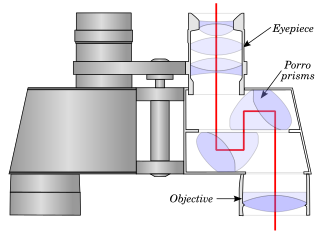
Binoculars or field glasses are two telescopes mounted side-by-side and aligned to point in the same direction, allowing the viewer to use both eyes when viewing distant objects. Most are sized to be held using both hands, although sizes vary widely from opera glasses to large pedestal mounted military models.
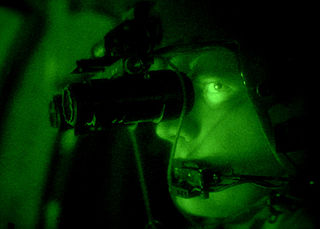
A night-vision device (NVD), also known as night optical/observation device (NOD) and night-vision goggles (NVG), is an optoelectronic device that allows images to be produced in levels of light approaching total darkness. The image may be a conversion to visible light of both visible light and near-infrared, while by convention detection of thermal infrared is denoted thermal imaging. The image produced is typically monochrome, e.g. shades of green. NVDs are most often used by the military and law enforcement agencies, but are available to civilian users. The term usually refers to a complete unit, including an image intensifier tube, a protective and generally water-resistant housing, and some type of mounting system. Many NVDs include a protective sacrificial lens, or optical components such as telescopic lenses or mirrors. An NVD may have an IR illuminator, making it an active as opposed to passive night-vision device.
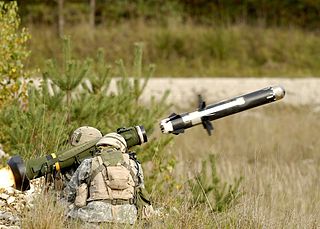
The FGM-148 Javelin is an American man-portable fire-and-forget anti-tank missile fielded to replace the M47 Dragon anti-tank missile in US service. It uses automatic infrared guidance that allows the user to seek cover immediately after launch, as opposed to wire-guided systems, like the Dragon, which require the user to actively guide the weapon throughout the engagement. The Javelin's HEAT warhead is capable of defeating modern tanks by attacking them from above where their armor is thinnest, and is also useful against fortifications in a direct attack flight.

The BGM-71 TOW is an American anti-tank missile. TOW replaced much smaller missiles like the SS.10 and ENTAC, offering roughly twice the effective range, a more powerful warhead, and a greatly improved semi-automatic guidance system that could also be equipped with infrared cameras for night time use.

Advanced Combat Optical Gunsight is a series of telescopic sights manufactured by Trijicon. The ACOG was originally designed to be used on the M16 rifle and M4 carbine, but Trijicon has also developed ACOG accessories for other firearms. Models provide fixed power magnification levels from 1.5× to 6×. ACOG reticles are illuminated at night by an internal phosphor. Some versions have an additional daytime reticle illumination via a passive external fiber optic light pipe or are LED-illuminated using a battery. The first ACOG model, known as the TA01, was released in 1987.

A reticle, or reticule, also known as a graticule, is a pattern of fine lines or markings built into the eyepiece of a sighting device, such as a telescopic sight in a telescope, a microscope, or the screen of an oscilloscope, to provide measurement references during visual examination. Today, engraved lines or embedded fibers may be replaced by a computer-generated image superimposed on a screen or eyepiece. Both terms may be used to describe any set of lines used for optical measurement, but in modern use reticle is most commonly used for gunsights and such, while graticule is more widely used for the oscilloscope display, microscope slides, and similar roles.
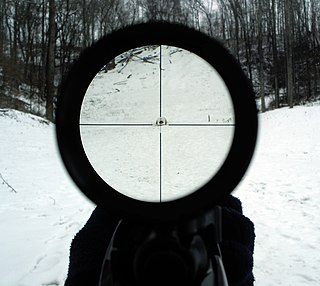
A telescopic sight, commonly called a scope, is an optical sighting device that is based on a refracting telescope. It is equipped with some form of graphic image pattern mounted in an optically appropriate position in its optical system to give an accurate aiming point. Telescopic sights are used with all types of systems that require accurate aiming but are most commonly found on firearms, particularly rifles. Other types of sights are iron sights, reflector (reflex) sights, and laser sights. The optical components may be combined with optoelectronics to form a night scope.

A tactical light is a flashlight used in conjunction with a firearm to aid low-light target identification, allowing the marksman, law enforcement officer or soldier to simultaneously aim a weapon and illuminate the target. Tactical lights can be handheld or mounted to the weapon with the light beam parallel to the bore. Tactical lights also serve a role as a method of non-lethal force, used to temporarily blind and disorient targets or, in the case of a large metal Maglite with D batteries, police can use the flashlight as a billy club. Features particularly associated with tactical lights include shock resistance, reliability, lightweight construction and powerful, long-lasting batteries, and high light intensity. Tactical lights may have optional filters to produce colored light ,e.g red light, to not attract bugs or be with a diffuser for directing traffic in low light places or night, or may emit only infrared radiation for use with night vision equipment. A sighting laser may also be added to a weapon-mounted tactical light.

The Sight Unit Small Arms, Trilux, or SUSAT, is a 4× telescopic sight, with tritium-powered illumination utilised at dusk or dawn. The full name of the current model is the SUSAT L9A1. The sight is not designed as a sniper sight, but is rather intended to be mounted on a variety of rifles and to be used by all infantrymen. A similar device is the Advanced Combat Optical Gunsight.

EOTECH is an American company that designs, manufactures, and markets electro-optic products and systems. The company is headquartered in Ann Arbor, Michigan. They produce holographic weapon sights for small arms that have been adopted by various military and law enforcement agencies as close quarters battle firearm sights.

AN/PVS-4 is the U.S. military designation for a specification of the first second generation passive Night vision device.

A red dot sight is a common classification for a type of non-magnifying reflector sight for firearms, and other devices that require aiming, that gives the user an aimpoint in the form of an illuminated red dot. A standard design uses a red light-emitting diode (LED) at the focus of collimating optics which generates a dot style illuminated reticle that stays in alignment with the weapon the sight is attached to regardless of eye position. They are considered to be fast-acquisition and easy-to-use gun sights for target shooting, hunting, and in police and military applications. Aside from firearm applications, they are also used on cameras and telescopes. On cameras they are used to photograph flying aircraft, birds in flight, and other distant, quickly moving subjects. Telescopes have a narrow field of view and therefore are often equipped with a secondary "finder scope" such as a red dot sight.
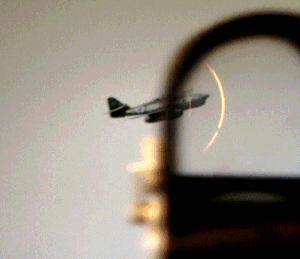
A reflector sight or reflex sight is an optical device that allows the user to look through a partially reflecting glass element and see an illuminated projection of an aiming point or some other image superimposed on the field of view. These sights work on the simple optical principle that anything at the focus of a lens or curved mirror will appear to be sitting in front of the viewer at infinity. Reflector sights employ some sort of "reflector" to allow the viewer to see the infinity image and the field of view at the same time, either by bouncing the image created by lens off a slanted glass plate, or by using a mostly clear curved glass reflector that images the reticle while the viewer looks through the reflector. Since the reticle is at infinity it stays in alignment with the device the sight is attached to regardless of the viewer's eye position, removing most of the parallax and other sighting errors found in simple sighting devices.

The AN/PSQ-20 Enhanced Night Vision Goggle (ENVG) is a third-generation passive monocular night vision device developed for the United States Armed Forces by ITT Exelis. It fuses image-intensifying and thermal-imaging technologies, enabling vision in conditions with very little light. The two methods can be used simultaneously or individually. The ENVG was selected by the US Army's Program Executive Office Soldier as a supporting device for the Future Force Warrior program in 2004, and is intended to replace the older AN/PVS-7 and AN/PVS-14 systems. Although more expensive and heavier than previous models, US Special Forces began using the goggles in 2008 and the US Army's 10th Mountain Division began fielding the AN/PSQ-20 in 2009. Improvements to the goggles have been attempted to make them lighter, as well as enabling the transmission of digital images to and from the battlefield.
The PSL is a Romanian military designated marksman rifle. It is also called PSL-54C, Romak III, FPK and SSG-97. Though similar in appearance to the SVD Dragunov, the PSL rifle is mechanically completely different and based on the RPK light machine gun.

A holographic weapon sight or holographic diffraction sight is a non-magnifying gunsight that allows the user to look through a glass optical window and see a holographic reticle image superimposed at a distance on the field of view. The hologram of the reticle is built into the window and is illuminated by a laser diode.
1PN51-2 is the GRAU index for a Soviet designed passive night scope for the RPG-29 rocket launcher. 1PN is the GRAU index of night vision devices, where PN stands for Nochnoy Pritsel meaning night sight.
1PN51 is the GRAU index for a Soviet designed passive night scope for a range of Soviet designed small arms and grenade launchers. 1PN is the GRAU index of night vision devices, where PN stands for Nochnoy Pritsel meaning night sight.
1PN58 is the GRAU index for a Soviet designed passive night scope for a range of Soviet designed small arms and grenade launchers. 1PN is the GRAU index of night vision devices, where PN stands for Nochnoy Pritsel meaning night sight. It is also called NSPUM.
The AN/PVS-17 Miniature Night Sight (MNS) is a compact, lightweight and high performance night vision weapon sight in wide use by the United States Special Forces and United States Marine Corps (USMC). The AN/PVS-17 is a Generation III Night Vision Device and uses the OMNI IV MX 10160 3rd generation image intensifier tube and can also be used as a handheld observation device. The designation AN/PVS translates to Army/Navy Portable Visual Search, according to Joint Electronics Type Designation System guidelines.
















